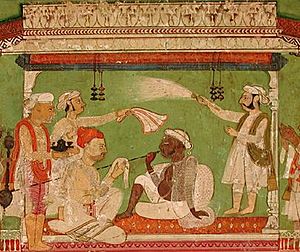Raghoji II of Nagpur facts for kids
Quick facts for kids Raghuji II |
|
|---|---|
| Maharaja of Nagpur | |

Raghuji Bhonsle II
|
|
| 4th Raja of Nagpur | |
| Reign | 19 May 1788 – 22 March 1816 |
| Predecessor | Raghoji II |
| Successor | Parsoji |
| Died | 22 March 1816 Nagpur |
| Spouse | Baka Bai |
| Issue | Parasoji II Bhonsle Dharmaji Bhonsle Raghuji Bhonsle III (adoptive son) |
| House | Bhonsles of Nagpur |
| Father | Madhoji Bhonsle |
| Religion | Hinduism |
Raghuji II (died 22 March 1816) was a Maratha ruler. He governed the Kingdom of Nagpur in Central India. His rule lasted from 1788 to 1816.
Contents
Raghuji's Time as Ruler
Raghuji was adopted as a baby by his uncle, Janoji Bhonsle. Janoji chose him to be his heir. After Janoji died in 1772, his brothers fought for control. Madhoji Bhonsle won this fight. He then became the regent, ruling for young Raghuji.
Nagpur Kingdom Grows
The Nagpur Kingdom became its biggest during the first half of Raghuji's rule. It was a time of great expansion.
Building and Beauty
Raghuji loved building things. He showed this by building a grand palace for himself. The palace took six years to complete. Skilled workers came from far away cities like Delhi and Varanasi. Masons and carpenters were given valuable golden bracelets as rewards.
The new palace had four large courtyards. It also featured five halls filled with mirrors. Raghuji also started a new area in Sonegaon. He built temples like Tulshibag and Ram-Kshetra. He also ordered the construction of Umred fort.
Life in the Palace
Every day, forty Brahmins ate meals at the Nagpur Bhonsle Palace. Raghuji built many temples. He ordered statues of Vishnu, Lakshmi, and Garuda from Pune. Religious events were celebrated with generous gifts to Brahmins. Cows with golden horns were given away during eclipses. About one lakh rupees were spent on charity each year. Many festivals were celebrated with joy throughout the year.
Gardens and Lakes
At the end of the 1700s, Nagpur was a city of beautiful lakes and gardens. A famous scholar, Henry Thomas Colebrooke, was given a bungalow. It was in the Telangkhedi garden. Henry described it as having straight paths and neat hedges.
Henry also wrote about Raghuji's own garden. He called it small but pretty. He noted its many buildings and splendid decorations. The garden looked especially lovely at night. Fountains played and the whole area lit up. In 1792, Raghuji spent a lot of money on the Tulshibag garden. Experts in gardening came from Cuttack. Many other gardens and lakes were also well-known. Nagpur city alone had over 1500 wells.
Horses and Fun
Like other rulers, Raghuji loved horses. His army had 10,000 horses. He bought horses from different regions. Horse dealers were often honored with special clothes. Raghuji was an excellent rider. He rewarded good riders with gold bracelets.
The Maratha leaders enjoyed many activities. Raghuji liked watching animal fights. He also enjoyed firing rockets and shooting arrows. Fishing, playing stick games, and boating were other pastimes.
Dancers and singers came to Nagpur from many places. They performed for the ruler. Singers were rewarded after showing their talent. Many famous male and female singers performed in the kingdom.
Despite some challenges, many people praised Raghuji II's rule. A traveler named Blunt visited in 1795. He wrote that the country was well-governed and highly cultivated. He found friendly people and plenty of food. Nagpur was a rich and happy city under Raghuji II.
Battles with the British
Between 1796 and 1798, Raghuji II gained control of Hoshangabad. In 1803, he joined forces with Daulat Rao Sindhia. They fought against the British East India Company. This was during the Second Anglo-Maratha War.
Loss of Land
The Maratha rulers lost badly in battles at Assaye and Argaon. By the Treaty of Deogaon, Raghuji had to give up land. He lost Cuttack, southern Berar, and Sambalpur to the British.
Before these wars, the Maratha government was generally good. The country was doing well. The first four Bhonsale rulers were strong military leaders. Their lands were mostly peaceful. Farming and income grew under a simple government system.
After the treaty, things changed. Raghuji II lost a third of his lands. He tried to make up for the lost money. Villages were heavily taxed. Many new taxes were added.
Other Conflicts
During the wars with the British, the Nawab of Bhopal took some land from the Bhonsles. In 1807, Raghuji sent his army to get it back. Later, he agreed with the Shindes to attack Bhopal together. Their armies surrounded Bhopal fort in 1814. But Raghuji pulled his forces back when the Nawab asked the British for help.
The soldiers were not paid on time. They often took things from farmers to survive. At the same time, groups called Pindaris started raiding. They became so bold that in 1811, they reached Nagpur. They even burned parts of the city. This is when many village forts were built. Farmers would hide in these forts when raiders came. They fought for their lives, losing everything outside the walls.
Raghuji died on 22 March 1816. His son, Parsoji II, became the next ruler.
Personal Life
Raghuji II's favorite queen was Baka Bai. He was known for being very religious. He was also very devoted to his mother.

